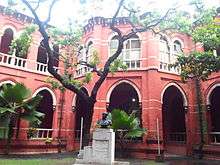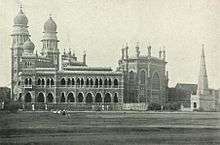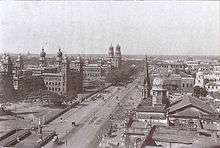Dr. Ambedkar Government Law College, Chennai
 | |
| Motto |
Fiat justitia ruat caelum ("Let justice be done though the heavens fall.") |
|---|---|
| Type | Government Law College |
| Established | 1891 |
Parent institution |
1891-1996: University of Madras 1996-present: Tamil Nadu Dr. Ambedkar Law University |
| Students | 562 |
| Location | Chennai, Tamil Nadu, India |
| Nickname | AGLC |
| Website | http://www.draglc.ac.in/ |
Dr. Ambedkar Government Law College (often referred to as Government Law College or GLC, Chennai) is a law college, located in Chennai, Tamil Nadu, India, established in 1891. It was formerly known as Madras Law College. It is a prestigious institution that produced several legal luminaries of the 20th century. But today, it stands neglected due to lack of funds and the arrival of many other law schools. In 1990, it was renamed by the Government of Tamil Nadu in commemoration of the birth centenary of Dr. B.R. Ambedkar, the father of Indian constitution. Since 1997, It has been affiliated to the Tamil Nadu Dr. Ambedkar Law University, splitting from the University of Madras.
History
The Legal Education in Tamil Nadu has a long and interesting history. Advocate General Mr. George Norton was the first to conceive the idea of Legal education in Madras. The genesis of Legal Education can be traced to the informal law classes conducted by him in his house in the form of conversations in the early 19th century. In 1852, at the direction of Sir Henry Eldred Pottinger, the Governor of Madras from 1848–1854, a Government High School was expanded into the Presidency College, Chennai.
Mr. John Bruce Norton, who was appointed as the first Professor of law in 1855, delivered his lectures at the Presidency College, Chennai. Till 1884, there was only one Professor of Law in the Presidency College, Chennai. In order to supplement lectures by tutorials, a second Professor was appointed in 1884. To him, the tutorial work was entrusted. The Scheme was put on trial for two years. Since it proved a success, it was continued for two more years from 1 January 1886.
Mr. H.B. Grigg, the Director of Public Instruction, evinced keen interest in improving the status of the legal education. He sent a proposal to the Government for setting up a Central Law College in Madras. The Government concurred with the conclusion of the Director of Public Instruction that changes were necessary in the arrangements for Law Instruction and that an independent institution should be established.
In 1885, Mr. Justice T. Muthuswamy Iyer gave his warm support to the proposal. The establishment of the Law College as an independent institution under the control of the Director of Public instruction was sanctioned by the Secretary of State, on the advice of the Council of Legal Studies (Education) in London. Mr. Reginald, A. Nelson, the first Principal, entered upon his duties on 2 May 1891.
Thus, the Law College came into existence. For seven and a half years after birth, it had no habitation of its own and the College was housed at the Senate House of the University of Madras. A project to place the new institution as near the High Court as possible led to the selection of a site for erecting a structure to the west of the High Court building. The present building of the Law College was designed by Mr.Henry Irwin, the Government Architect. The Law College moved into this building on 9 January 1899. As a natural consequence of gaining a building of its own, the Law College was converted into a whole time institution.[1]
The Diamond Jubilee of Madras Law College was celebrated on 14 March 1952.[2] P. V. Rajamannar, the first Indian to become the Chief Justice of the Madras High Court, presided over the function.


Admission
At present, the admissions are made through Tamil Nadu Dr. Ambedkar Law University. It enrolls 562 students every year.
Academics
In the early seventies, the College was upgraded into a Post Graduate Institution with the introduction of M.L. Courses. It primarily offers 5 years integrated B.A.,B.L and 3 years B.G.L. Under-graduate programmes.
From 1973-74, the Tamil Language has also been made as a medium of instruction in Law as part of a Government Policy to introduce Tamil as Official Language at all levels in the State.
With a view to upgrading the standards of legal education, B.A.B.L., (Hons) course was initially introduced in the college from the academic year 2002-2003. But the same was shifted to the Tamil Nadu Dr. Ambedkar Law University with effect from the academic year 2006-2007.
Campus
The Madras Law College is located within the campus of High Court of Madras and looks very similar to the High Court structures. Many South-Indian movies usually portray the Law college structures as Court halls wherever the court scenes are involved.
The College's Primary structure is a classic example of Indo-Saracenic Architectural style, built by English architects Robert Fellowes Chisholm and Henry Irwin. This building houses most of the Administrative sections of the College and the Moot Hall. The Library used to be there until a separate block was built for it. A Newer block houses most of the class rooms these days. The College campus contains a few other old structures and tombs.
The College doesn't provide a hostel within its campus. The Law college Men's Hostel has been at 92, Millers Road Kilpauk, Chennai since 1959 and the Law college Women's Hostel is at 133, Walajah Road, Chepauk, Chennai. The Hostels are allotted on the basis of merit.
Culture
The College has been the center of many controversies starting from late 90's. Very often, the students of the college were involved in strikes and the college has seen a lot of politics. There have been many instances where the students clashed among themselves violently due to some caste-based politics. But nevertheless, there have always been another class of students dedicated to studies.
The College has been actively participating in many Moot courts, both in India and Internationally. It has won quite a lot of Moot Courts.
It occasionally hosts its own National level Moot Court Competition called as FIAT JUSTITIA. It was last conducted in 2010.
List of Principals
1891-1913: R.A. Nelson
1913-1927: Arthur Davies
1928-1929: M. Rathnaswami
1930-1949: K. Krishna Menon
1949-1952: S. Govindarajulu Naidu
1967-1968: A.Palaniswami
1974-1978: C. Rajaraman
1978-1983: Master Sankaran
1983-1995: T. Audiseshan
1995-1997: S.Narayanaswamy
2002-2004: Dr. G.C. Kothandan
2004-2005: Dr.G.P.Godhana Gandhi
2005-2006: C.Robin
2006-2008: Dr. J.Jayamani
2008-2011: M. Mohamed Iqbal
2011-2012: K. Balaji Naidu
2012-2013: Dr. S.Narayanaperumal
2013-2014 Dr.N.S.Santhosh Kumar
2014–present Dr.K.Murugadoos
Notable alumni
Kindly note that this list is incomplete and a lot of distinguished personalities may be missing.
Presidents
- R. Venkataraman, 8th President of India (1987–1992)
Chief Justices of India
- M. Patanjali Sastri, 2nd Chief Justice of India (from 1951–1954)
- Koka Subba Rao, 9th Chief Justice of India (from 1958–1967) and was also a Chief Justice of Andhra Pradesh High Court (1956–1958)
- P. Sathasivam, 40th Chief Justice of India (in 2013) and is the current Governor of Kerela
Judges of the Supreme Court of India
- P. Satyanarayana Raju, Judge, Supreme Court of India (1965–1966) and was also the Chief Justice of Andhra Pradesh High Court (1964–1965)
- V. Balakrishna Eradi, Judge, Supreme court of India (1981) and was also the Chief Justice of Kerala High Court (1980)
Judges of the High Courts
- M. Karpagavinayagam, Chief Justice of the Jharkhand High Court[3] (2006)
- V. Periyakaruppiah, Judge, High Court of Madras (2007–2012)
- P. D. Dinakaran, Chief Justice of Sikkim High Court (2008–2011)
Chief Ministers of States
- Damodaram Sanjivayya, Chief Minister of Andhra Pradesh (1960–1964)
- M. Bhaktavatsalam, Chief Minister of Madras State (1963-1967)
- Kotla Vijaya Bhaskara Reddy, Chief Minister of Andhra Pradesh (1982–1983; 1992–94)
Ministers
- E. Ikkanda Warrier, Last Prime Minister of State of Cochin
- V. K. Krishna Menon
- P Chidambaram, former Finance Minister of India
- V. K. Krishna Menon, former Defence Minister of India
- M. A. Ayyangar, the first Deputy Speaker of the Lok Sabha and the Speaker of the 2nd Lok Sabha[4]
- Dr.John Mathai, India's first Railway Minister and subsequently Finance Minister under First Nehru ministry.
- R. K. Shanmukham Chetty, India's first Finance Minister
- Murasoli Maran
- S. Kumaraswami Reddiar
- Mohammad Shahabuddin
- A. Ranganatha Mudaliar, Minister of Public Health and Excise for the Madras Presidency
Advocates
- P. S. Sivaswami Iyer, Advocate General of Madras (1907–1911)
- C. Sankaran Nair, Advocate General of Madras (1908) and President of the Indian National Congress (1897)
Others
- M. B. Nirmal, Social Activist & Founder, Exnora International
- T. N. Manoharan, Chartered Accountant and former president of Institute of Chartered Accountants of India
- E. Krishna Iyer, a freedom-fighter, classical artist and activist
- Digavalli Venkata Siva Rao, Historian and Telugu writer
- D. R. Karthikeyan, special director of the Central Bureau of Investigation (1998) and Director General, National Human Rights Commission
- Swami Vireshwarananda, tenth president of the Ramakrishna Math and Ramakrishna Mission
References
- ↑ History of the College, Official Website.
- ↑ dated 15 March 1952: Law and Life, The Hindu. Friday, 15 Mar 2002
- ↑ Hon’ble Mr. Justice M.Karpaga Vinayagam, Jharkhand High Court, Official Website
- ↑ A fitting tribute to son of the soil, The Hindu. 14 April 2007
External links
Coordinates: 13°5′15.17″N 80°17′8.27″E / 13.0875472°N 80.2856306°E